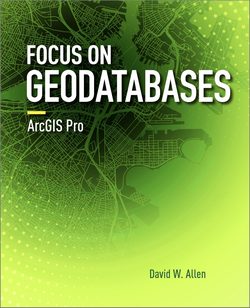Читать книгу Focus on Geodatabases in ArcGIS Pro - David W. Allen - Страница 5
ОглавлениеIntroduction
The ArcGIS® platform uses the geodatabase as the spatial data format of choice for desktop, enterprise, web, and mobile applications. Within the geodatabase, you can store points, lines, polygons, tables, and other features for practically any application. As spatial data becomes more prolific across many platforms, the issue of maintaining the quality of both existing and newly created data has come to the forefront. Those in charge of managing these spatial datasets need the ability to control how they are created and edited to maintain this quality.
The geodatabase contains many parameters and options that the user can preset to help maintain data integrity in spatial datasets. Knowing what these components are and how to design them is crucial to building a new geodatabase, whether it is for local or enterprise use or even for use with online or mobile apps. And once these features are built into your data schema, it is important to know how to place your data into the geodatabase to take full advantage of these tools. Maintaining data integrity doesn’t stop with building and importing data; it extends into editing existing data and creating new data. The editing interface includes many tools that work with the geodatabase to enforce the rules of data integrity, so the proper use of these tools is critical to maintaining your data at the highest standards. It’s even possible to hide the nature of these data integrity rules so that they don’t interfere with the normal workflow, but they can be used to steer the user toward the proper data entry techniques. This book explores many of those tools, including default values, field domains, subtype categories, relationship rules, editing constraints and data entry control, custom feature templates, and more—all of which, when combined, will provide a solid editing experience designed to maintain your data integrity.
This book will take you through designing, building, and editing your datasets using all the latest features and enhancements. Each chapter discusses the major concepts and includes hands-on tutorials that take you step by step through various focused topics. The tutorials include a sample project file in which you can practice the skills outlined, datasets to work with, special Your Turn segments in which you can practice earlier concepts, a review with study questions for classroom use, and an independent exercise that you can work through to ensure you have mastered the concepts. Chapter topics include the careful design of a geodatabase schema, building geodatabases that include data integrity rules, populating your geodatabases with existing data, sharing the data on the web and building 3D views, creating new features, editing the data with various techniques, and working with topologies.
Data for the book’s tutorials is available in ArcGIS Online. For instructions on downloading it, see “Access the data” in chapter 1.
Instructor resources are available by request, at esripress@esri.com.
